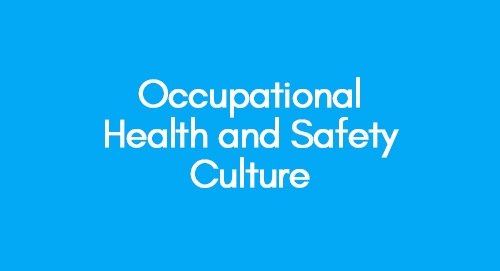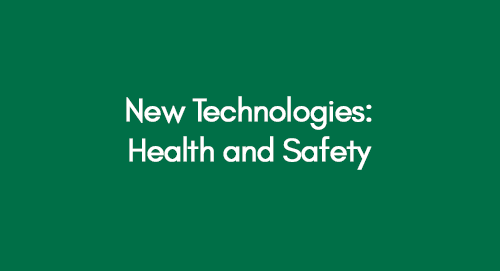
Occupational Health and Safety Culture
December 18, 2020
Application of Customer-based Brand Equity Model (CBBE) and the Sources of Brand Equity for ROLEX
December 19, 2020The study "New Technologies: Health and Safety" investigates how recent innovations are transforming safety and well-being practices in various industries, aiming to demonstrate the impact of these technologies.
The succeeding section examines the study's introduction.
Introduction
Architecture, Engineering and Construction Industry refers to three component team players that have been brought together in the AEC Industry to get a project to its total capacity and realisation. The purpose of the integration of seemingly different but inherently correlated industries was to bring together all these three industries so that they could work together efficiently and collaborate with ease.
Given the rate at which technology and society are advancing, it is noted that seventy per cent of the Fortune 1000 companies that had been published ten years ago have now been completely disrupted. This process of technological infiltration and its negative impacts on the business is said to undergo a process known as disruptive selection, whereby in a society where technological advancement is so fast and liquid that the organisations are unable to adapt themselves to the changes- digital Darwinism, the organisations than as a result tend to lose their market share (Doherty, 2014).
With the ever-growing need and subsequent advancement of technology coupled with globalisation based in an economy that is not only global but also digital, organisations are thrust forward into introducing new business models. This is not only done at a rate that, in comparison to before, has increased ten times but also at fairly cheaper costs which results in a transformation and subsequent disruption of the industry processes (Park et al, 2013). This is equally applicable to the architecture, engineering and construction industries.
In order to survive in an ever-changing global era of technological advancements, the industry must be infiltrated with technology, as is the topic of discussion for this paper, in order to either survive or disrupt itself internally to bring itself in line with other industry players within the digital economy (Wong et al., 2014). However, these advancements and their impacts extend beyond the basic premise of the industry and have an impact on the health and safety of the built environment.
In this section, you'll find a review of the literature.
Literature Review
Doherty, 2014, states that the Architecture, Engineering and Construction Industry has found itself in the middle of an elastic shift which is powerful because of its transparency and subtlety. This is owed to the advancement in technology and invariably connected devices, which are bound to bring significant changes not only through unexplored opportunities but also through putting the industry in the face of varying degrees of challenges.
Explore the Architectural Technologies
This section explores a few of the prominent digital technologies that have made their way into the industry, however, this list is for discussion purposes and is not an exhaustive list of technologies and their subsequent impact on health and safety.
Building Information Modelling
Building Information Modelling, usually written as BIM, involves looking into the physical as well as the functional characteristics of any place through management and generation of practices that are digital in nature. Computer-generated information in the Building Information Models are used for decision-making on the characteristics of a particular place which can also be exchanged or networked in the form of data (Park et al., 2013).
The basic purpose of BIM is to bring together all the information about all the characteristics in one place. This allows access to all the inherent key players who can integrate various aspects of the environment efficiently, thereby reducing cost, discrepancies and mistakes (Volk et al., 2014). The figure below illustrates the use of BIM throughout the building cycle of the architectural engineering and construction industry.

Figure 1 Building Lifecycle of a Project and the use of BIM (source: Messner, 2009)
BIM is a great tool that has been used for visualisation. It puts forth a virtual three-dimensional representation of the project undergoing the building stage, which helps in making decisions about the design, and the space functionality. Although the integrated information used in the model normally includes structural information, pricing/costing, material-related data and various other forms of data, health and safety (H&S) related information, including the legislations and safety procedures, are yet not formally integrated into this system. However, this developing tool in the construction industry has revolutionized the current practices and enhanced the overall engineering aspects of the projects, which supports the sustainability, resilience and adaptability aspects, and further increases process optimizations at various fronts, hence improving the H&S aspects of the team involved. This can be argued because of the fact the project manager can obtain up-to-date real-time comprehensive information on the works on site allowing them to perceive any hazard that may occur more accurately. However, it can not be denied that further research and consequent implications are necessary to integrate training, procedures, risk mitigation measures and analyses related to H&S data into the BIM system for further improvements (Jones, 2014).
RFID Tagging
RFID Tagging system is a tracking and identification system which uses small devices operated on radio frequencies. They are attached to the objects and contain all sorts of tracing information transmitted through the frequencies. It can be used for the maintenance of quality by allowing the component users to connect to a website through the RFID tag and download relevant information (Meza et al, 2014). Furthermore, safety can be ensured by referring to instructions, and verifying procedures can be easy and fast (Milgram et al., 1994).
Also, the products can be grouped and their varying locations can be monitored. Another critical aspect of RFID tagging is that with the current globalised green environment, the devices can be used for varying requirements, such as during the demolition of buildings or construction, which can be utilised to enhance the health and safety aspects of the project. However, it must be observed that tailored utilisation of such tools is required to practically enhance the safety aspects in accordance with the requirements (Rice, 2010).
Augmented reality enhances real-world experiences by overlaying digital information or elements onto the physical environment.
Augmented Reality
Augmented reality encompasses the live direct or indirect viewing of a real environment, elements and characteristics of which are augmented or simply supplemented by a sensory input generated through a computer which may include GPS data, sounds, graphics and videos. Through object recognition and computer vision, the information present can be virtually interactive while allowing the user to manipulate it digitally to enhance communication (Jones, 2014). Augmented reality is a recent entrant into the Architecture engineering and construction industry, which allows the architects to look into a third-dimensional image of the paper version of the proposed design through mobile phones or other models. The use of augmented reality goes beyond mere visualisations and is illustrated through the case of the Christchurch earthquake in 2011, where the engineers and city planners used the visualisations of the destroyed buildings to draw a comparison between the devastation of the structure and the initial material used; which shown that this technology can be used to strengthen further the health and safety implications of the industry (Yoders, 2014)
Virtual Reality
Virtual Reality, also known as computer-stimulated life allows the user to interact in a real or imaginary stimulated place using artificially created experiences using senses such as sight, touch and smell (Baldwin et al, 2009). The architecture, engineering and construction industry relies heavily on visualizations. Virtual reality allows the users to share the buildings through a computer-generated image, making construction not only innovative but also cost-effective. It ensures a distinct clarity in the architectural design of the building since the architects and contractors can enter into the virtual reality and modify it from within (Wong et al., 2014). A very recent though important aspect of virtual reality is its use to educate technicians in assembling, remodelling, modifying or examining complicated machinery, which can all prove to have an influential aspect in structuring optimised health and safety procedures in various industrial activities (Mullin, 2013).
Prefabrication
Prefabrication is another digital technological process implemented within the Architecture Engineering and Construction Industry, with the primary aim of reducing the cost of labour and time while enhancing the accuracy of the construction design (Keegan, 2010). The process involves the use of various technologies, first and foremost the BIM for specifications and sequences for all the building components which are then translated through the fabrication software. Following this, Computer Numerical Control technology is used for the fabrication of a particular product.
In various cases, BIM can be used for the enhancement of the exchange of information between various participants which can be followed by fabrication through details obtained from the product (Hergunsel, 2011). After the prefabrication and arrival of the products on the site, then coordination between the superintendent and the trade specialists takes place, which ensures that the virtual third-dimensional design will transform into a reality. This type of technological advancement reduces on-site manufacturing, allowing the provision of easy installations, which reduces on-site activities of human resources involved, thus reducing the probability of accidents on site. Therefore, advancements in pre-fabrication technologies can potentially have a huge impact on improving the overall health and safety aspects of the construction industry.
Discussion
With the increase in technological innovation throughout the globe, it is imperative and inevitable for the architecture, engineering and construction industry to profiteer with new technological devices (Boyce and Luck, 2015). In recent years, the industry has been dependent on the use of digital technologies. Where it has been documented to have various benefits, it is also imperative to note the multiple risks it poses for health and safety within the built environment. First and foremost, where it is important to have information available to all the required parties, it also gives rise to information theft or unintentional disclosure of data which would have a negative impact on the security of not only the asset but also the occupants of the built environment (Jiao et al, 2013).
Moreover, all the collaborators need to discuss and be aware of the risks associated with the projects. Security can be extended to national threat issues, including terrorism, to sustain the preserved use of built assets. This includes not only maintaining a built structure but also preventing any disclosure of intellectual property and data that may be deemed commercially sensitive (Hergunsel, 2011). This security-minded approach should be adopted at the beginning of the project so that an initial assessment of the asset can reveal its vulnerability and sensitivity and protect the appropriate data.
Digital technologies, when applied and implemented with scrutiny, will help in keeping the built environment safe and secure. Through augmented reality and BIM, situations that can lead to injury can be identified and subsequently prevented (Wong et al., 2014). RFID tagging and BIM can be used for prefabrication while ensuring that all energy inputs and outputs are authentic and have not been modified. Furthermore, prompt tracking ensures the reliability and availability of the product efficiently (Almagor, 2014). RFID Tagging and prefabrication can be used to ensure that certain data remains confidential. If it is used with proper thoroughness, it can be used to circumvent any potential negative impact of unintentional disclosure of information (Jiao et al, 2013).
Since access to complete technology is not available throughout the organisation, it can be manipulated to ensure configuration and consistency while ensuring that there is no undue interference with the running of the organisation. Data can be managed through the use of these technologies so that it can be used at a later time or for a later project as a reference (Wong et al., 2014).
Furthermore, these technologies, such as virtual and augmented reality, allow all the participants to analyse the materials used in a construction project and identify their defects so that they can be removed or prevented when rebuilding. It can ensure the safety of the occupants, the workers and others included by allowing the identification of hazards and circumventing them before their appearance (Meza et al, 2014).
In this section, we delve into the study's conclusions and findings.
Conclusion
It is imperative for the architect, engineering and construction industry to embrace to the notion of collaborative working through not only effective communication but also sharing enormous amount of data with openness. This is not only useful for new buildings or refurbishments but will be effective in the management of assets in the long term through the use of real-time data for the analysis of the buildings. Digital technology in the industry has opened up new avenues of opportunities to enhance innovation, and efficiency and ensure sustainability through reduced costs. However, there are various vulnerability as well as application issues that need to be addressed, followed by the implementation of control methods to ensure optimum health and safety within the built environment. For example, unintentional disclosure of information can be fatal to the company and needs to be addressed by implementing a security measure that allows collaboration without compromising safety. Moreover, further integration of H&S data into computer-aided systems is required to ensure successful implications for industrial safety (Keegan, 2010).
Health and Safety measures need to be implemented at every level within the organisation, beginning with proposing the idea and delivering the said product, including the chain supply management in between. Digital innovation through virtual and augmented reality has allowed the users to interact with their project in a third-dimensional feature which is imperative to the health and safety of the built environment. BIM coupled with virtual and augmented reality can be safely implemented for use in a project to ensure optimum health and safety. However, it is again pertinent to point out that the vulnerability that comes forth with this technological advancement can only be efficient through utilisation of state of the art technical tools in an open, collaborative process between the architecture, engineering and construction organisations.
References
- Almagor, A. (2014). Mixed Reality for the AEC Industry Extending Trimble’s Product Capabilities with Microsoft HoloLens. Trimble Navigation.
- Baldwin A., Li H., Huang T., Kong C.W., Guo H.L., Chan N. and Wong J. (2009). Supporting pre-tender construction planning with virtual prototyping, Engineering, Construction and Architectural Management. 1Vol. 16, No.2, 150-161.
- Boyce, H. and Luck, A. (2015). Digital Risk: what BIM means for industry security. Construction news. Published on 1-October-2015. Available at: http://www.cnplus.co.uk/news/analysis/digital-risk-what-bim-means-for-industry-security/8689780.article#.VjZSj7crLIU.
- Dohetry, P. (2014). The impact of Augmented Reality and Virtual Reality on the AEC industry. Construction executive. Published on 4- February-2014. Available at: http://enewsletters.constructionexec.com/techtrends/2014/02/augmented-reality-effect-on-the-aec-world/.
- Hergunsel, M. (2011). Benefits of Building Information Modelling for Construction Managers and BIM-based Scheduling. Worcester Polytechnic Institute.
- Jiao Y., Zhang S., Li Y., Wang Y. and Yang B. (2013). Towards cloud augmented reality for construction application by BIM and SNS integration, Automation in Construction, Vol.33, 37–47
- Jones, K. (2014). Five ways the construction industry will benefit from augmented reality. Construction Data Company. Published on 5- August 2014. Available at: https://www.linkedin.com/pulse/20140805163603-41493855-five-ways-the-construction-industry-will-benefit-from-augmented-reality.
- Keegan, C. (2010). Building Information Modelling in Support of Spatial Planning and Renovation in Colleges and Universities. Thesis. WPI, 2010. WPI Electronic Theses and Dissertations.
- Meza S., Turk Z. and Dolenc M. (2014). Component-based engineering of a mobile BIM-based augmented reality system. Automation in Construction, Vol.42, 1-12.
- Milgram, Paul; H. Takemura; A. Utsumi; F. Kishino (1994). "Augmented Reality: A class of displays on the reality-virtuality continuum. Trimble.
- Mullin, L. (2013). How BIM can improve management of health and safety. Construction Technical Specialist. Autodesk.
- Park C., Lee D., Kwon O. and Wang X. (2013). A Framework for Proactive Construction Defect Management using BIM, Augmented Reality and Ontology-based Data Collection Template. Automation in Construction, Vol.33, 61-71.
- Rice, S. (2010). "The Perceived Value of Building Information Modelling in the U.S. Building Industry." Journal of Information Technology in Construction 15 (2010): 185-201.
- Volk R., Stengel J. and Schultmann F. (2014). Building Information Models (BIM) for existing buildings – literature review and future needs, Automation in Construction, Vol.38, 109-127.
- Wong, J., Wang, X, Li, H., Chan, G., Li, H. (2014). A review of cloud based BIM technology in the construction sector. Journal of Information Technology in Construction. ISSN 1874-4753
Yoders, R. (2014). What is Augmented Reality, and how can it help architects and contractors? Line Shape Space. Published on 21-March-2014. Available at: http://lineshapespace.com/what-is-augmented-reality/.
Get 3+ Free Dissertation Topics within 24 hours?




























